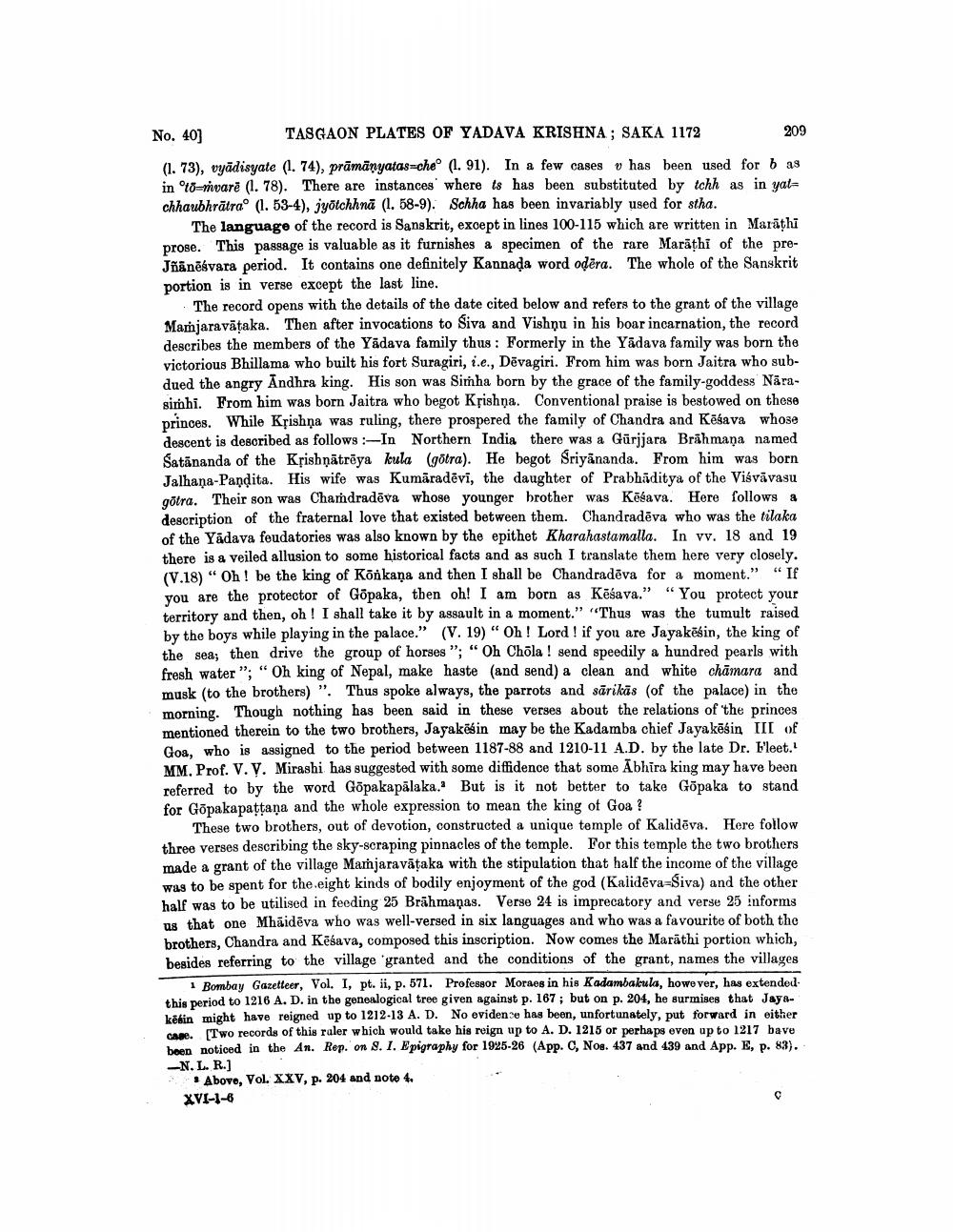________________
No. 40) TASGAON PLATES OF YADAVA KRISHNA; SAKA 1172
209 (1. 73), vyādisyate (1.74), prāmāngatas-cheo (1. 91). In a few cases v has been used for b as in oto=mvarē (l. 78). There are instances where is has been substituted by ichh as in yat= chhaubhrātrao (1. 53-4), jyotchhnă (1. 58-9). Schha has been invariably used for stha.
The language of the record is Sanskrit, except in lines 100-115 which are written in Marathi prose. This passage is valuable as it furnishes a specimen of the rare Marathi of the preJñanēsvara period. It contains one definitely Kannada word odera. The whole of the Sanskrit portion is in verge except the last line.
The record opens with the details of the date cited below and refers to the grant of the village Marjaravätaka. Then after invocations to Siva and Vishnu in his boar incarnation, the record describes the members of the Yädava family thus : Formerly in the Yadava family was born the victorious Bhillama who built his fort Suragiri, i.e., Dēvagiri. From him was born Jaitra who subdued the angry Andhra king. His son was Simha born by the grace of the family-goddess Närasimhi. From him was born Jaitra who begot Kțishna. Conventional praise is bestowed on these princes. While Krishna was ruling, there prospered the family of Chandra and Kesava whose descent is described as follows: In Northern India there was a Gürjjara Brāhmana named Satānanda of the Krishnätröya kula (götra). He begot Sriyananda. From him was born Jalhaņa-Pandita. His wife was Kumāradēvi, the daughter of Prabhaditya of the Visvāvasu gotra. Their son was Chamdradēva whose younger brother was Kēšava. Here follows a description of the fraternal love that existed between them. Chandradēva who was the tilaka of the Yādava feudatories was also known by the epithet Kharahastamalla. In vv. 18 and 19 there is a veiled allusion to some historical facts and as such I translate them here very closely. (V.18) “Oh! be the king of Könkana and then I shall be Chandradova for a moment." "If you are the protector of Göpaka, then oh! I am born as Kēšava." "You protect your territory and then, oh! I shall take it by assault in a moment." "Thus was the tumult raised by the boys while playing in the palace." (V. 19) " Oh ! Lord ! if you are Jayakësin, the king of the sea; then drive the group of horses"; "Oh Chola ! send speedily a hundred pearls with fresh water": "Oh king of Nepal, make haste and send) a clean and white chamara and musk (to the brothers)". Thus spoke always, the parrots and särikäs (of the palace) in the morning. Though nothing has been said in these verses about the relations of the princes mentioned therein to the two brothers, Jayakēsin may be the Kadamba chief Jayakēģin III of Goa, who is assigned to the period between 1187-88 and 1210-11 A.D. by the late Dr. b'leet. MM. Prof. V.V. Mirashi has suggested with some diffidence that some Abhira king may have been referred to by the word Gõpakapālaka. But is it not better to take Göpaka to stand for Göpakapattana and the whole expression to mean the king of Goa?
These two brothers, out of devotion, constructed a unique temple of Kalidēva. Here follow three verses describing the sky-scraping pinnacles of the temple. For this temple the two brothers made a grant of the village Mamjaravātaka with the stipulation that half the income of the village was to be spent for the eight kinds of bodily enjoyment of the god (Kalidēva-Siva) and the other half was to be utilisod in feeding 25 Brāhmaṇas. Verse 24 is imprecatory and verse 25 informs us that one Mhāidēva who was well-versed in six languages and who was a favourite of both the brothers, Chandra and Kesava, composed this inscription. Now comes the Marathi portion which, besides referring to the village 'granted and the conditions of the grant, names the villages
1 Bombay Gazetteer, Vol. I, pt. ii, p. 571. Professor Moraes in his Kadambakula, however, has extended this period to 1216 A. D. in the genealogical tree given against p. 167; but on p. 204, he surmises that Jaykēkin might have reigned up to 1212-13 A. D. No evidene has been, unfortunately, put forward in either CNB. [Two records of this ruler which would take his reign up to A. D. 1218 or perhaps even up to 1217 bave been noticed in the An. Rep. on 8. 1. Epigraphy for 1925-26 (App. C, Nog. 437 and 439 and App. E, p. 83). -N. L. R.]
Above, Vol. XXV, p. 204 and note 4. XVI-1-6




